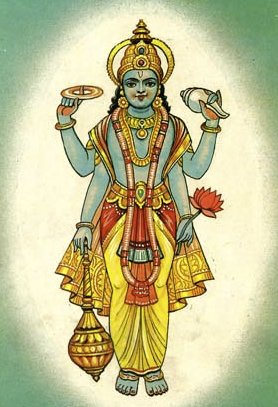Svapa, Svāpa, Shvapa: 12 definitions
Introduction:
Svapa means something in Hinduism, Sanskrit. If you want to know the exact meaning, history, etymology or English translation of this term then check out the descriptions on this page. Add your comment or reference to a book if you want to contribute to this summary article.
In Hinduism
Vaishnavism (Vaishava dharma)
Source: VedaBase: Śrīmad BhāgavatamSvāpa (स्वाप) refers to “sleep”; mentioned as characteristics of intelligence (buddhi) in the Śrīmad Bhāgavatam 3.26.30.—Smṛti means “memory”, and svāpa means “sleep”. Sleep is also necessary to keep the intelligence in working order. If there is no sleep, the brain cannot work nicely. In Bhagavad-gītā it is especially mentioned that persons who regulate eating, sleeping and other necessities of the body in the proper proportion become very successful in the yoga process.

Vaishnava (वैष्णव, vaiṣṇava) or vaishnavism (vaiṣṇavism) represents a tradition of Hinduism worshipping Vishnu as the supreme Lord. Similar to the Shaktism and Shaivism traditions, Vaishnavism also developed as an individual movement, famous for its exposition of the dashavatara (‘ten avatars of Vishnu’).
Ayurveda (science of life)
Source: gurumukhi.ru: Ayurveda glossary of termsSvāpa (स्वाप):—Numbness

Āyurveda (आयुर्वेद, ayurveda) is a branch of Indian science dealing with medicine, herbalism, taxology, anatomy, surgery, alchemy and related topics. Traditional practice of Āyurveda in ancient India dates back to at least the first millenium BC. Literature is commonly written in Sanskrit using various poetic metres.
Purana and Itihasa (epic history)
Source: archive.org: Shiva Purana - English TranslationSvāpa (स्वाप) refers to “sleeping (on a cushioned couch)”, according to the Śivapurāṇa 2.5.5 (“The Tripuras are fascinated).—Accordingly, as Arihan said to the Lord of the Three Cities: “O ruler of the Asuras, listen to my statement, pregnant with wisdom. It is the essence of the Vedānta and bears high esoteric importance. [...] Let there be hundreds of horses, of different varieties. But for the purpose of riding only one can be used on one occasion. The pleasure that one derives in that sleep (svāpa) on a cushioned couch is the same that one derives by sleeping on the bare ground. Just as we, the embodied beings, are afraid of death so also the bodies from Brahmā to the worm are afraid of death. [...]”.

The Purana (पुराण, purāṇas) refers to Sanskrit literature preserving ancient India’s vast cultural history, including historical legends, religious ceremonies, various arts and sciences. The eighteen mahapuranas total over 400,000 shlokas (metrical couplets) and date to at least several centuries BCE.
Languages of India and abroad
Sanskrit dictionary
Source: DDSA: The practical Sanskrit-English dictionarySvāpa (स्वाप).—[svap-ghañ]
1) Sleep, sleeping; स्वापहेतुरनुपाश्रितोऽ न्यया रामबाहुरुपधानमेष ते (svāpaheturanupāśrito' nyayā rāmabāhurupadhānameṣa te) Uttararāmacarita 1.37.
2) Dreaming, dream.
3) Sleepiness, sloth.
4) Paralysis, palsy, insensibility.
5) Temporary or partial loss of sensation from pressure on a nerve, numbness.
Derivable forms: svāpaḥ (स्वापः).
Source: Cologne Digital Sanskrit Dictionaries: Shabda-Sagara Sanskrit-English DictionarySvāpa (स्वाप).—m.
(-paḥ) 1. Sleep, sleeping. 2. Sleepiness, sloth. 3. Paralysis, palsy, loss of sensation. 4. Ignorance. 5. Dreaming, a dream. 6. Temporary and partial palsy from pressure on a nerve, numbness, the sleep of a limb, &c. E. ṣvap to sleep, aff. ghañ .
Source: Cologne Digital Sanskrit Dictionaries: Benfey Sanskrit-English DictionarySvāpa (स्वाप).—i. e. svap + a, m. 1. Sleeping, [Uttara Rāmacarita, 2. ed. Calc., 1862.] 24, 7; sleep. 2. Sleepiness. 3. Loss of sensation. 4. The sleep of a limb. 5. Ignorance. 6. Dream.
Source: Cologne Digital Sanskrit Dictionaries: Cappeller Sanskrit-English DictionarySvāpa (स्वाप).—[masculine] sleep, dream.
Source: Cologne Digital Sanskrit Dictionaries: Monier-Williams Sanskrit-English Dictionary1) Śvapa (श्वप):—[=śva-pa] [from śva > śvan] m. ‘keeper of d°’, a possessor of d°, [Harivaṃśa]
2) Svāpa (स्वाप):—[from svap] a m. sleeping, sleep, [Suśruta; Kathāsaritsāgara; Bhāgavata-purāṇa]
3) [v.s. ...] dreaming, a dream, [Prabodha-candrodaya; Bhāgavata-purāṇa]
4) [v.s. ...] sleepiness, sloth, [Horace H. Wilson]
5) [v.s. ...] the sleep of a limb, numbness, [Suśruta]
6) [v.s. ...] loss of sensation, ignorance, [cf. Lexicographers, esp. such as amarasiṃha, halāyudha, hemacandra, etc.]
7) b etc. See p. 1280, col. 3.
Source: Cologne Digital Sanskrit Dictionaries: Yates Sanskrit-English DictionarySvāpa (स्वाप):—(paḥ) 1. m. Sleep, sleeping; sloth; palsy; ignorance; dream; sleep of a limb.
Source: DDSA: Paia-sadda-mahannavo; a comprehensive Prakrit Hindi dictionary (S)Svāpa (स्वाप) in the Sanskrit language is related to the Prakrit word: Sāva.
[Sanskrit to German]
Sanskrit, also spelled संस्कृतम् (saṃskṛtam), is an ancient language of India commonly seen as the grandmother of the Indo-European language family (even English!). Closely allied with Prakrit and Pali, Sanskrit is more exhaustive in both grammar and terms and has the most extensive collection of literature in the world, greatly surpassing its sister-languages Greek and Latin.
Kannada-English dictionary
Source: Alar: Kannada-English corpusSvāpa (ಸ್ವಾಪ):—
1) [noun] sleeping; sleep.
2) [noun] dreaming; a dream.
3) [noun] sleepiness; sloth.
4) [noun] loss of sensation; numbness.
Kannada is a Dravidian language (as opposed to the Indo-European language family) mainly spoken in the southwestern region of India.
See also (Relevant definitions)
Starts with (+51): Shvapac, Shvapaca, Shvapacaka, Shvapacata, Shvapacatva, Shvapach, Shvapacha, Shvapaci, Shvapad, Shvapada, Shvapadacarita, Shvapadanagara, Shvapadanusarana, Shvapadarajan, Shvapadasevita, Shvapaka, Shvapakaka, Shvapaki, Shvapamana, Shvapati.
Ends with: Ashvapa, Divasvapa, Indriyasvapa, Prasvapa, Sukhasvapa, Susvapa, Vishvapa.
Full-text (+1): Indriyasvapa, Svapas, Divasvapa, Svapavyasana, Anjiga, Sukhasvapa, Svapasy, Prasvapini, Susvapa, Prasvapa, Prasvapana, Prasvapaka, Nisvap, Svap, Svapana, Smriti, Shvapaka, Shava, Bhushayin, Svapna.
Relevant text
Search found 7 books and stories containing Svapa, Shva-pa, Shvapa, Śva-pa, Sva-pa, Svāpa, Śvapa; (plurals include: Svapas, pas, Shvapas, Svāpas, Śvapas). You can also click to the full overview containing English textual excerpts. Below are direct links for the most relevant articles:
Rig Veda (translation and commentary) (by H. H. Wilson)
Garga Samhita (English) (by Danavir Goswami)
Verse 2.11.5 < [Chapter 11 - The Liberation of Dhenukāsura]
Sahitya-kaumudi by Baladeva Vidyabhushana (by Gaurapada Dāsa)
Text 10.183 < [Chapter 10 - Ornaments of Meaning]
Siddhanta Sangraha of Sri Sailacharya (by E. Sowmya Narayanan)
The Matsya Purana (critical study) (by Kushal Kalita)
Part 4 - Rājadharma in the Matsyapurāṇa < [Chapter 6 - Polity in the Matsyapurāṇa]
Dvisahasri of Tembesvami (Summary and Study) (by Upadhyay Mihirkumar Sudhirbhai)